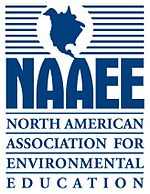- North American Association for Environmental Education
-
The North American Association for Environmental Education (NAAEE) states its mission as promoting "excellence in environmental education and serves environmental educators for the purpose of achieving environmental literacy in order for present and future generations to benefit from a safe and healthy environment and a better quality of life."[1]
The NAAEE has established the following "Guidelines for Excellence" for environmental education:[2]
1. Fairness and accuracy: EE materials should be fair and accurate in describing environmental problems, issues, and conditions, and in reflecting the diversity of perspectives on them.
- 1.1 Factual accuracy.
- 1.2 Balanced presentation of differing viewpoints and theories.
- 1.3 Openness to inquiry.
- 1.4 Reflection of diversity.
2. Depth: EE materials should foster an awareness of the natural and built environment, an understanding of environmental concepts, conditions, and issues, and an awareness of the feelings, values, attitudes, and perceptions at the heart of environmental issues, as appropriate for different developmental levels.
- 2.1 Awareness.
- 2.2 Focus on concepts.
- 2.3 Concepts in context.
- 2.4 Attention to different scales.
3. Emphasis on skills building: EE materials should build lifelong skills that enable learners to address environmental issues.
- 3.1 Critical and creative thinking.
- 3.2 Applying skills to issues.
- 3.3 Action skills.
4. Action orientation: EE materials should promote civic responsibility, encouraging learners to use their knowledge, personal skills, and assessments of environmental issues as a basis for environmental problem solving and action.
- 4.1 Sense of personal stake and responsibility.
- 4.2 Self-efficacy.
5. Instructional soundness: EE materials should rely on instructional techniques that create an effective learning environment.
- 5.1 Learner-centered instruction.
- 5.2 Different ways of learning.
- 5.3 Connection to learners’ everyday lives.
- 5.4 Expanded learning environment.
- 5.5 Interdisciplinary.
- 5.6 Goals and objectives.
- 5.7 Appropriateness for specific learning settings.
- 5.8 Assessment.
6. Usability: EE materials should be well designed and easy to use.
- 6.1 Clarity and logic.
- 6.2 Easy to use.
- 6.3 Long lived.
- 6.4 Adaptable.
- 6.5 Accompanied by instruction and support.
- 6.6 Make substantiated claims.
- 6.7 Fit with national, state, or local requirements.
See also
- Environmental education
- Environmental education in the United States
References
External links
Categories:- Environmental education by region
- 1.1 Factual accuracy.
Wikimedia Foundation. 2010.

